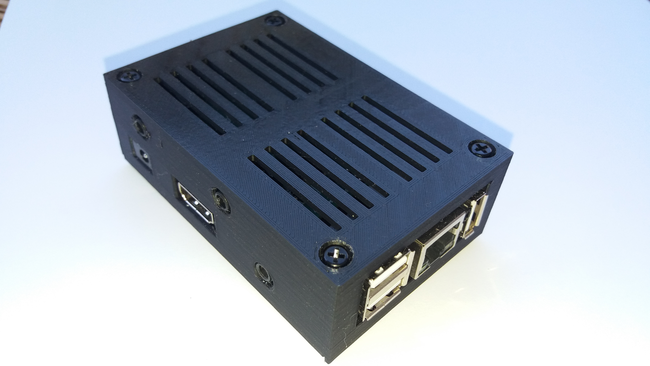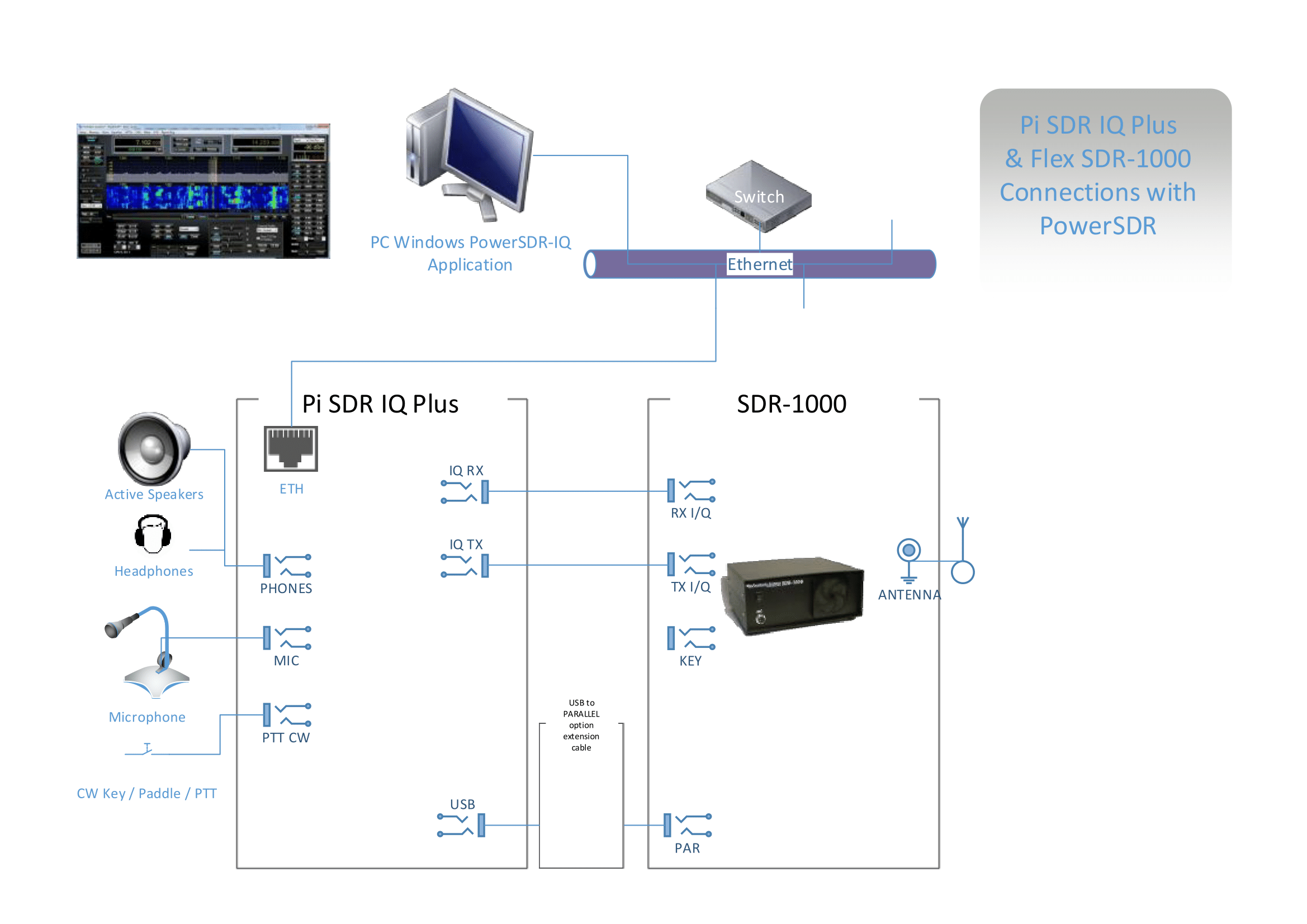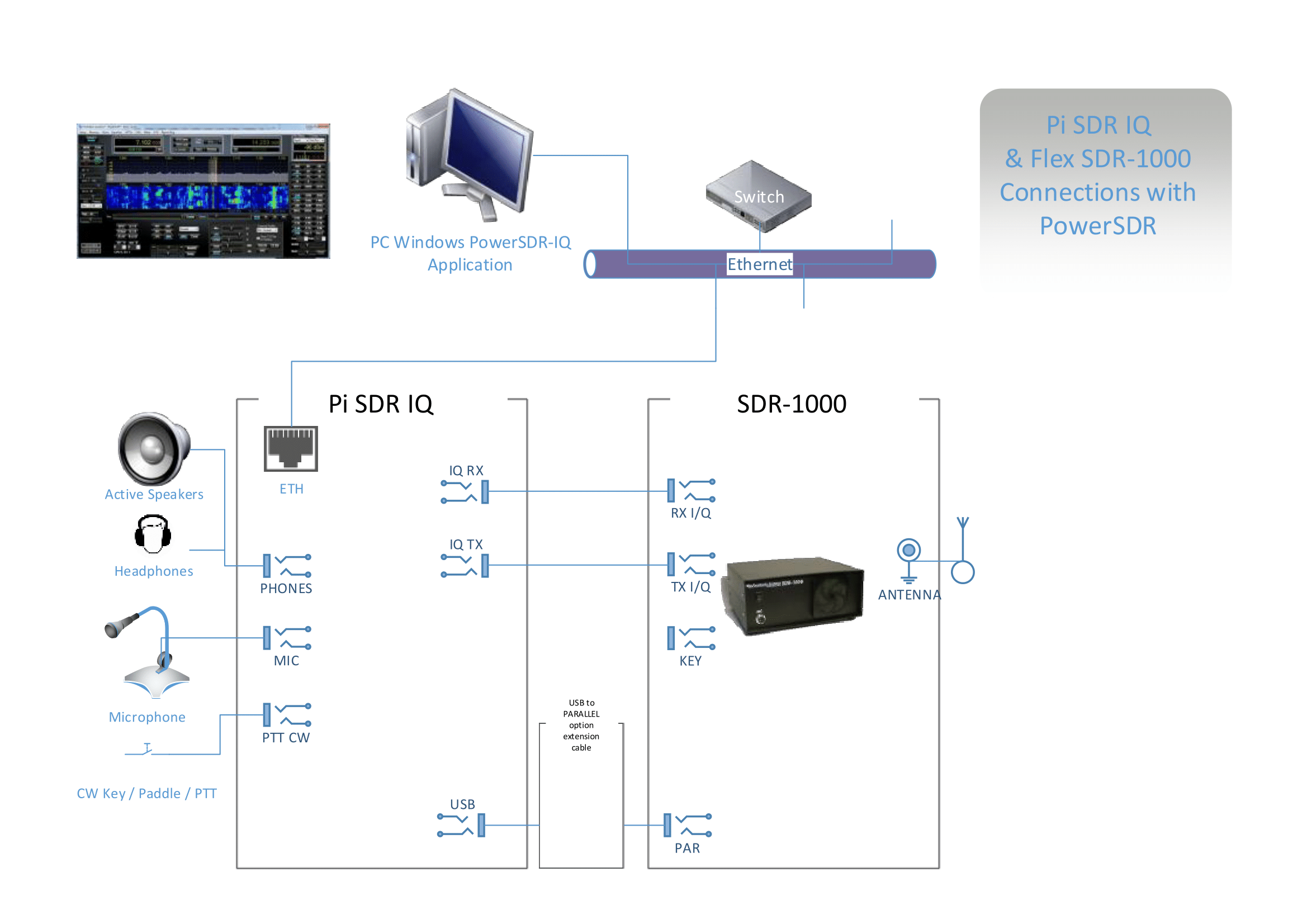Pi SDR IQ Plus
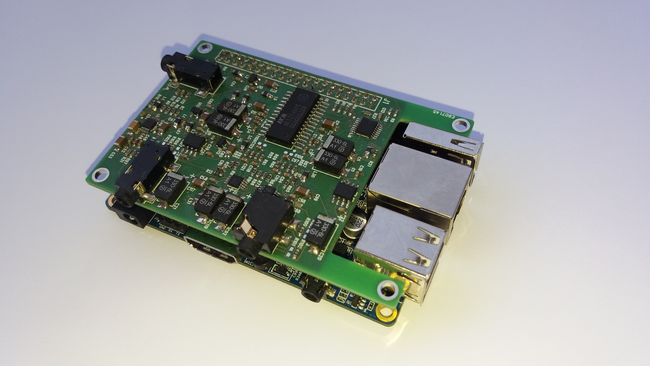
Pi SDR IQ Plus, is a new interface designed to suit the specific SDR ADC/DAC requirements of Flex SDR1000 and Softrock/Ensemble or compatible homemade rigs. Also it is designed to work with a network connection giving versatile topology. That means the Pi SDR IQ interface will just sit happily with your rig and only an Ethernet cable connection is required to your local network. And of course have hassle-free operation, ready-made configuration with ease of setup.
Currently the supported rigs are
- Flexradio SDR1000
- Softrock/Ensemble and compatibles
- RS-HFIQ
- Genesis G59 with GPA10 & G11 (experimental)
Even if you do not have a local ethernet network around with router or network switch, Pi SDR IQ Plus can be fully utilized with just connecting a ethernet cable from your PC's ethernet port, directly to Pi SDR IQ Plus's ethernet port. As simple as that you could have a non-networked PC with Pi SDR IQ Plus fully working setup. Pi SDR IQ Plus and the controlling PC running PowerSDR are required to be within the same ethernet local area network.
The Pi SDR IQ Plus is a high end solution featuring the AK5394A ADC giving 123dB of Rx dynamic range to your homebrew rig. Contains an ADC/DAC board attached on a included SBC with a quad-core ARM A7 CPU. It is a ready-made working combo package. There is no need for a user provided SBC (eg RPi) as it already contains its own aforementioned quad core ARM A7 SBC. All necessary IQ Rx, IQ Tx, Headphones, Mic, CW, USB host, all jack/connections for the Softrock/Ensemble and ethernet port for connection to PC/PowerSDR are included. Its firmware resides in a 8GB SD Card so upgrades are as easy as changing the SD card.
For Windows users, these will be accompanied by a new PowerSDR application (based on v2.5.3) specific to utilize the new I/Q interfaces. Its operation is transparent, just make the cable connections, start the application and you're up and running.
Support for SDR1000 is in place with the use of an add-on, the Pi SDR LPT. Using this add-on, SDR1000 rigs got revitalized and now can be used in a transparent way with all the modern PCs with Windows 7/8/10 and the familiar PowerSDR application.
For SDR1000 rigs, the RFE board is required to be present.
On G59 rigs, the GPA10 is required and on G11 rigs the multiband board is required.
For a standalone operation, without using a dedicated PC, there is a firmware version for Pi SDR IQ Plus that by attaching a HDMI monitor, a keyboard and a mouse, a work desktop is shown utilising Quisk, WSJT-X and Fldigi. In that setup, user can have phone and digimodes based on the included widely used applications. In that configuration two rig types are supported, RS-HFIQ and Ensemble RxTx, for more information on this setup click here.
Specifications, Pi SDR IQ Plus with AK5394A/CS4344
- IQ ADC jack, 123 dB Dynamic Range/24bits/192KHz
- IQ DAC jack, 105 dB Dynamic Range/24bits/192KHz
- Stereo Headphones/Microphone jack
- CW/Paddles jack
- SBC ARM A7 QuadCore/1.53GHz/1GBRAM/100MBEth/USB2/HDMI
- Used natively with PowerSDR-IQ v2.5.3, Win7/8/10
- Driverless configuration, no PC drivers required.
Firmware for the Pi SDR operation can be downloaded freely in the Support section and users can flash it to their choice of SD card, alternatively there is an option to buy a SD card already flashed with required firmware.
Options
- Pi SDR LPT, for connecting to a Flex SDR1000 control port or controlling other external DIY devices
- Pi SDR IQ Enclosure, 9cm X 6cm X 3cm
- Pi SDR IQ 5V Power Supply
- Pi SDR IQ 8GB SD firmware card
For SDR1000 users, there is more detailed information in the Pi SDR IQ Plus for SDR1000 page
Reviews in eham can be seen here http://www.eham.net/reviews/detail/13675
Pi SDR IQ Plus, Ports & Connectors
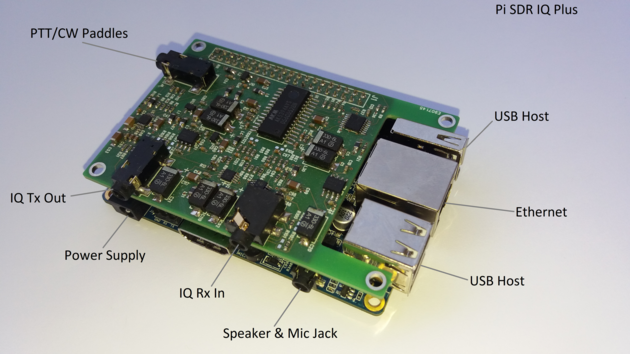
Softrock/Ensemble Connections

Pi SDR IQ Plus and SDR1000 video
PowerSDR IQ v2.5.3

Standalone FT8 operation with Quisk and WSJT-X, Pi SDR Linux desktop firmware
Plus Board on RPi
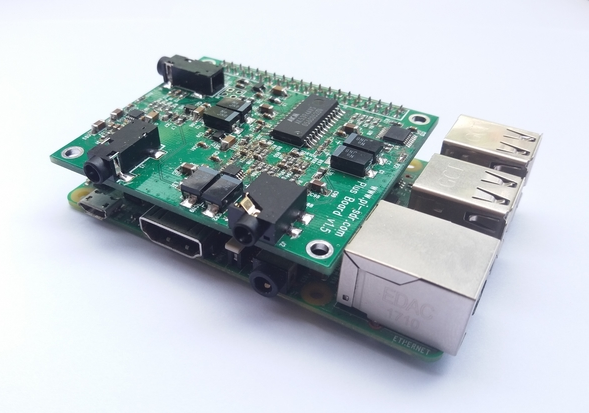
Plus Board on RPi, is a new interface board as a Raspberry Pi top added board, for owners of a Raspberry Pi 3B/3B+/4B, designed to suit the specific SDR ADC/DAC requirements of Flex SDR1000 and Softrock/Ensemble or compatible homemade rigs. Utilizing RPi's network capabilities can work with a network connection giving versatile topology. That means the RPi with the Plus interface will just sit happily with your rig and only an Ethernet cable connection is required to your local network. Your Windows PC then with the provided PowerSDR application will take control. And of course have hassle-free operation, ready-made configuration with ease of setup.
Currently the supported rigs are
- Flexradio SDR1000
- Softrock/Ensemble and compatibles
- RS-HFIQ
- Genesis G59 & G11 (experimental)
The Plus board on RPi is a high end solution featuring the AK5394A ADC giving 123dB of Rx dynamic range to your homebrew rig. It contains also the CS4344 105dB DAC for driving rig's Tx. It is having Rx IQ, Tx IQ and CW/PTT ports, though the user here has to provide the Headphones and Mic connections. That can be done eg with a simple USB dongle audio card or USB headphones/mic headset attached to one of RPi's USB ports. Its firmware resides in a 8GB SD Card so upgrades are as easy as changing the SD card.
For Windows users, these will be accompanied by a new PowerSDR application (based on v2.5.3) specific to utilize the new I/Q interfaces. Its operation is transparent, just make the cable connections, start the application and you're up and running.
Support for SDR1000 is in place with the use of an add-on, the Pi SDR LPT. Using this add-on, SDR1000 rigs got revitalized and now can be used in a transparent way with all the modern PCs with Windows 7/8/10 and the familiar PowerSDR application.
In this setup, no monitor, keyboard or mouse is required attached on the RPi. A dedicated and provided firmware is in place that is pre-configured and ready to go without any user interaction. In this setup, the RPi will exclusively be used for the purpose of handling the connected transceiver.
For SDR1000 rigs, the RFE board is required to be present.
On G59 rigs, the GPA10 is required and on G11 rigs the multiband board is required.
Specifications, Plus board with AK5394A/CS4344
- IQ ADC jack, 123 dB Dynamic Range/24bits/192KHz
- IQ DAC jack, 105 dB Dynamic Range/24bits/192KHz
- CW/Paddles jack
- Used natively with PowerSDR-IQ v2.5.3, Win7/8/10
- Driverless configuration, no PC drivers required.
Firmware for the Pi SDR operation can be downloaded freely in the Support section and users can flash it to their choice of SD card.
Options
- Pi SDR LPT, for connecting to a Flex SDR1000 control port
Reviews in eham can be seen here http://www.eham.net/reviews/detail/13675
Pi SDR Plus board
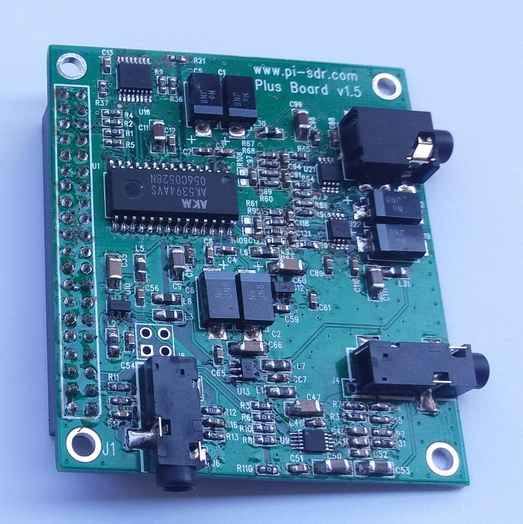
PowerSDR IQ v2.5.3

Standalone FT8 operation with Quisk and WSJT-X, RS-HFIQ rig, on RPi 3B
Used in another way, without a controlling PC with PowerSDR, by adding a monitor, keyboard & mouse to RPi there can be standalone operation with the Quisk application and WSJT-X and/or Fldigi for digimodes.
Rigs supported in that configuration are RS-HFIQ & Softrock/Ensemble and compatibles.
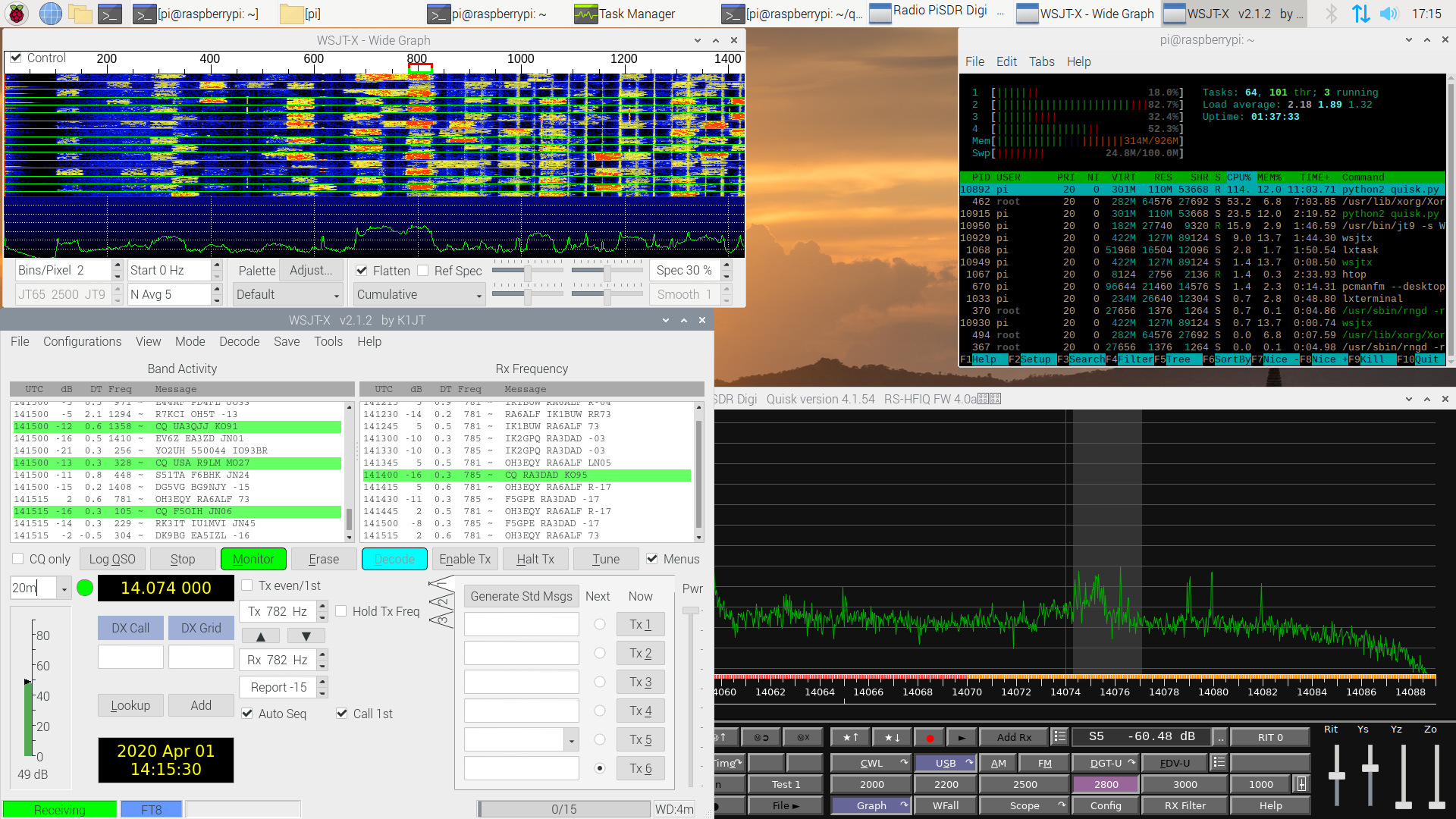
Solo Board on RPi
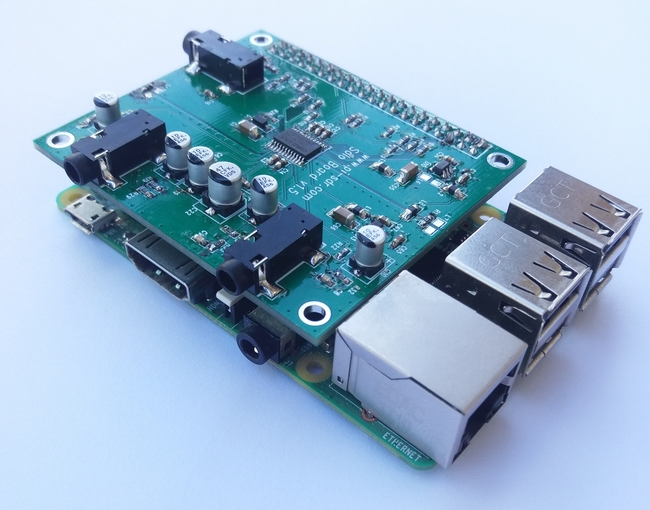
Solo Board on RPi, is a new interface board as a Raspberry Pi top added board, for owners of a Raspberry Pi 3B/3B+/4B, designed to suit the specific SDR ADC/DAC requirements of Flex SDR1000, RS-HFIQ, G59/G11 and Softrock/Ensemble or compatible homemade rigs. Utilizing RPi's network capabilities can work with a network connection giving versatile topology. That means the RPi with the Plus interface will just sit happily with your rig and only an Ethernet cable connection is required to your local network. Your Windows PC then with the provided PowerSDR application will take control. And of course have hassle-free operation, ready-made configuration with ease of setup.
Currently the supported rigs are
- Flexradio SDR1000
- Softrock/Ensemble and compatibles
- RS-HFIQ
- Genesis G59 & G11 (experimental)
The Solo board on RPi is a cost effective solution with CS4270 codec giving 105dB of Rx dynamic range to your homebrew rig. It is having Rx IQ, Tx IQ and CW/PTT ports, though the user here has to provide the Headphones and Mic connections. That can be done eg with a simple USB dongle audio card or USB headphones/mic headset attached to one of RPi's USB ports. Its firmware resides in a 8GB SD Card so upgrades are as easy as changing the SD card.
For Windows users, these will be accompanied by a new PowerSDR application (based on v2.5.3) specific to utilize the new I/Q interfaces. Its operation is transparent, just make the cable connections, start the application and you're up and running.
Support for SDR1000 is in place with the use of an add-on, the Pi SDR LPT. Using this add-on, SDR1000 rigs got revitalized and now can be used in a transparent way with all the modern PCs with Windows 7/8/10 and the familiar PowerSDR application.
In this setup, no monitor, keyboard or mouse is required attached on the RPi. A dedicated and provided firmware is in place that is pre-configured and ready to go without any user interaction. In this setup, the RPi will exclusively be used for the purpose of handling the connected transceiver.
For SDR1000 rigs, the RFE board is required to be present.
On G59 rigs, the GPA10 is required and on G11 rigs the multiband board is required.
Specifications, Solo Board for RPi with CS4270
- IQ ADC jack, 105 dB Dynamic Range/24bits/192KHz (*)
- IQ DAC jack, 105 dB Dynamic Range/24bits/192KHz
- CW/Paddles jack
- Used natively with PowerSDR-IQ v2.5.3, Win7/8/10
- Driverless configuration, no PC drivers required.
(* : Codec samplerate can be used up to 192KHz whereas the linear bandwidth in that configuration is 120KHz.)
Firmware for the Pi SDR operation can be downloaded freely in the Support section and users can flash it to their choice of SD card.
Options
- Pi SDR LPT, for connecting to a Flex SDR1000 control port
Reviews in eham can be seen here http://www.eham.net/reviews/detail/13675
Solo Board for RPi
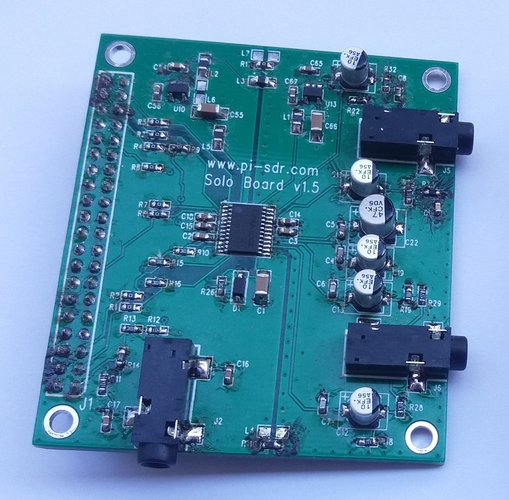
PowerSDR IQ v2.5.3
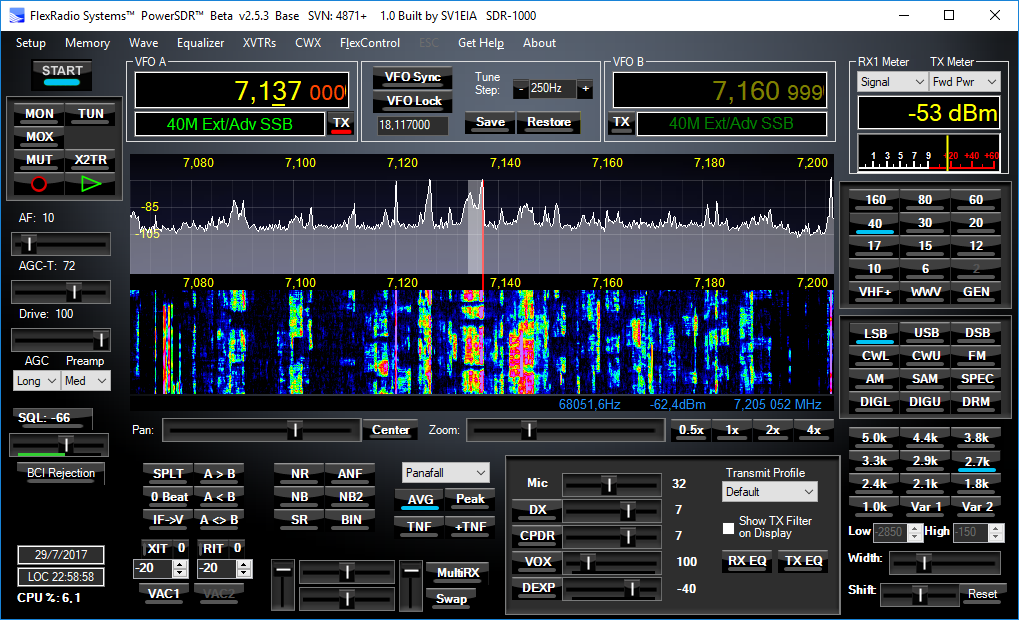
Standalone FT8 operation with Quisk and WSJT-X, RS-HFIQ rig, on RPi 3B
Used in another way, without a controlling PC with PowerSDR, by adding a monitor, keyboard & mouse to RPi there can be standalone operation with the Quisk application and WSJT-X and/or Fldigi for digimodes.
Rigs supported in that configuration are RS-HFIQ & Softrock/Ensemble and compatibles.

Pi SDR IQ Solo
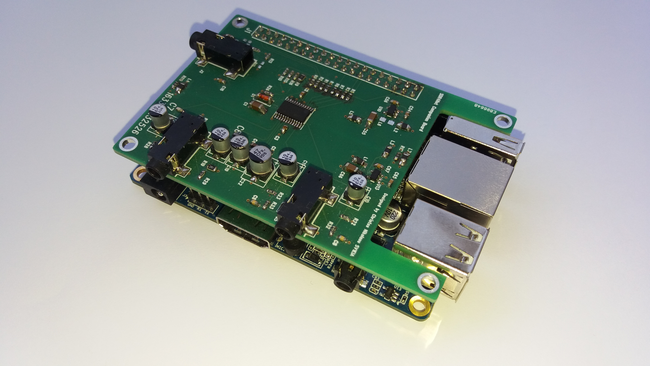
Pi SDR IQ Solo, is a new interface designed to suit the specific SDR ADC/DAC requirements of Flex SDR1000 and Softrock/Ensemble or compatible homemade rigs. Also it is designed to work with a network connection giving versatile topology. That means the Pi SDR IQ interface will just sit happily with your rig and only an Ethernet cable connection is required to your local network. And of course have hassle-free operation, ready-made configuration with ease of setup.
Currently the supported rigs are
- Flexradio SDR1000
- Softrock/Ensemble and compatibles
- RS-HFIQ
- Genesis G59 with GPA10 & G11 (experimental)
Even if you do not have a local ethernet network around with router or network switch, Pi SDR IQ Solo can be fully utilized with just connecting a ethernet cable from your PC's ethernet port, directly to Pi SDR IQ Solo's ethernet port. As simple as that you could have a non-networked PC with Pi SDR IQ Solo fully working setup. Pi SDR IQ Solo and the controlling PC running PowerSDR are required to be within the same ethernet local area network.
The Pi SDR IQ Solo is a cost effective solution with CS4270 codec giving 105dB of Rx dynamic range to your homebrew rig. Contains an ADC/DAC board attached on a included SBC with a quad-core ARM A7 CPU. It is a ready-made working combo package. There is no need for a user provided SBC (eg RPi) as it already contains its own aforementioned quad core ARM A7 SBC. All necessary IQ Rx, IQ Tx, Headphones, Mic, CW, USB host, all jack/connections for the Softrock/Ensemble and ethernet port for connection to PC/PowerSDR are included. Its firmware resides in a 8GB SD Card so upgrades are as easy as changing the SD card.
For Windows users, these will be accompanied by a new PowerSDR application (based on v2.5.3) specific to utilize the new I/Q interfaces. Its operation is transparent, just make the cable connections, start the application and you're up and running.
Support for SDR1000 is in place with the use of an add-on, the Pi SDR LPT. Using this add-on, SDR1000 rigs got revitalized and now can be used in a transparent way with all the modern PCs with Windows 7/8/10 and the familiar PowerSDR application.
For SDR1000 rigs, the RFE board is required to be present.
On G59 rigs, the GPA10 is required and on G11 rigs the multiband board is required.
For a standalone operation, without using a dedicated PC, there is a firmware version for Pi SDR IQ Solo that by attaching a HDMI monitor, a keyboard and a mouse, a work desktop is shown utilising Quisk, WSJT-X and Fldigi. In that setup, user can have phone and digimodes based on the included widely used applications. In that configuration two rig types are supported, RS-HFIQ and Ensemble RxTx.
Specifications, Pi SDR IQ Solo with CS4270
- IQ ADC jack, 105 dB Dynamic Range/24bits/192KHz (*)
- IQ DAC jack, 105 dB Dynamic Range/24bits/192KHz
- Stereo Headphones/Microphone jack
- CW/Paddles jack
- SBC ARM A7 QuadCore/1.53GHz/1GBRAM/100MBEth/USB2/HDMI
- Used natively with PowerSDR-IQ v2.5.3, Win7/8/10
- Driverless configuration, no PC drivers required.
(* : Codec samplerate can be used up to 192KHz whereas the linear bandwidth in that configuration is 120KHz.)
Firmware for the Pi SDR operation can be downloaded freely in the Support section and users can flash it to their choice of SD card, alternatively there is an option to buy a SD card already flashed with required firmware.
Options
- Pi SDR LPT, for connecting to a Flex SDR1000 control port or controlling other external DIY devices
- Pi SDR IQ Enclosure, 9cm X 6cm X 3cm
- Pi SDR IQ 5V Power Supply
- Pi SDR IQ 8GB SD firmware card
For SDR1000 users, there is more detailed information in the Pi SDR IQ Solo for SDR1000 page
Reviews in eham can be seen here http://www.eham.net/reviews/detail/13675
Pi SDR IQ Solo, Ports & Connectors
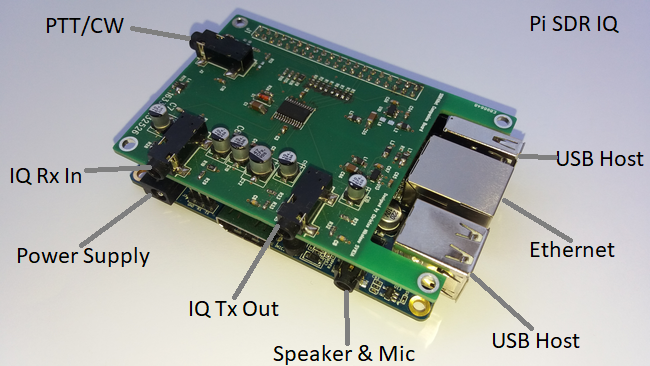
Softrock/Ensemble Connections

PowerSDR IQ v2.5.3

Standalone FT8 operation with Quisk and WSJT-X, Pi SDR Linux desktop firmware
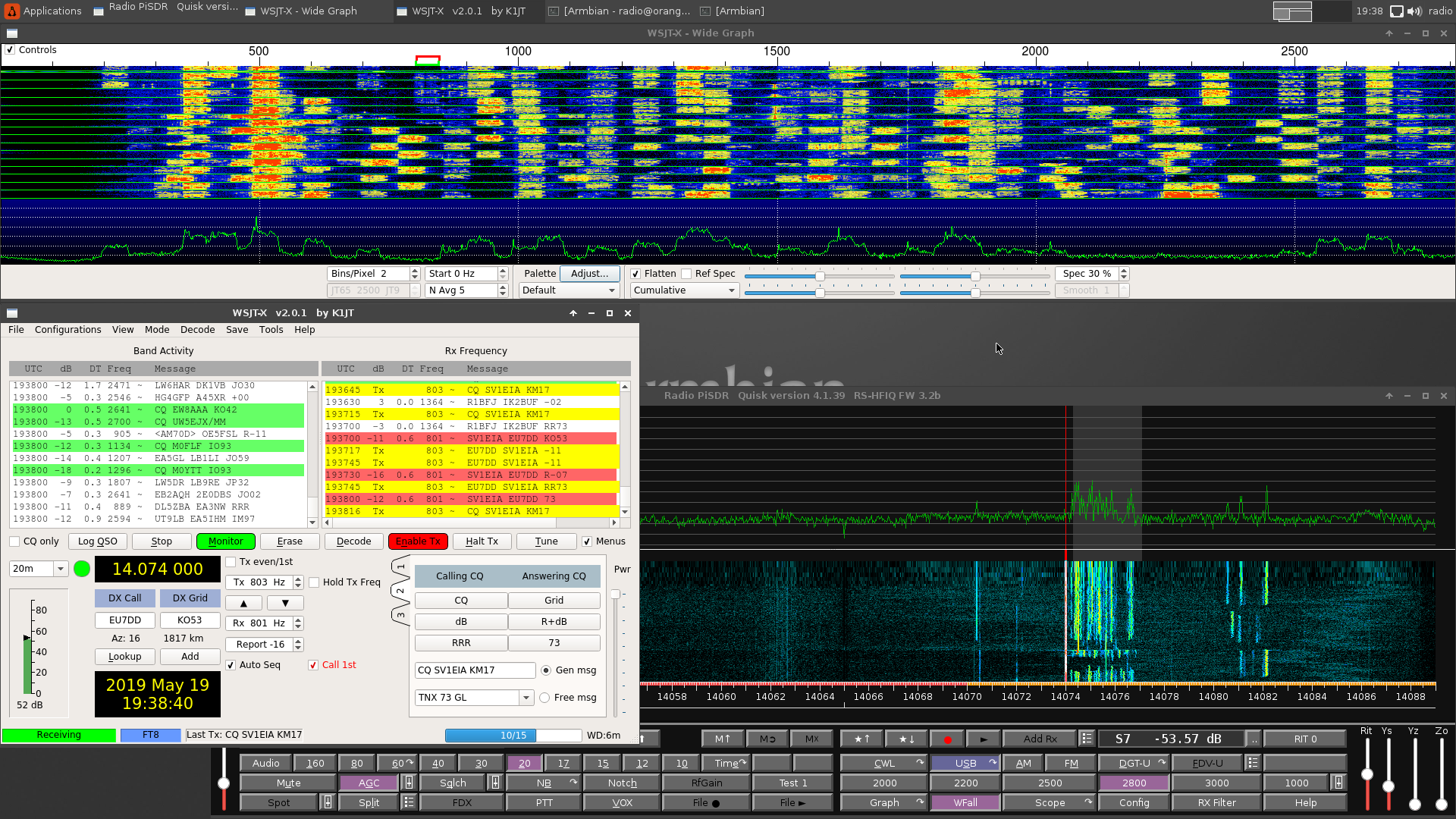
Planning for a new campaign in a few months as right now there is no availability due to global semiconductor shortage.
If you like to get Pi SDR IQ Plus information or if interested in backing the next campaign, you can send your enquiries directly via email to: This email address is being protected from spambots. You need JavaScript enabled to view it.
Here is our older Pi SDR Indiegogo campaign page
https://igg.me/at/pisdriqplus

